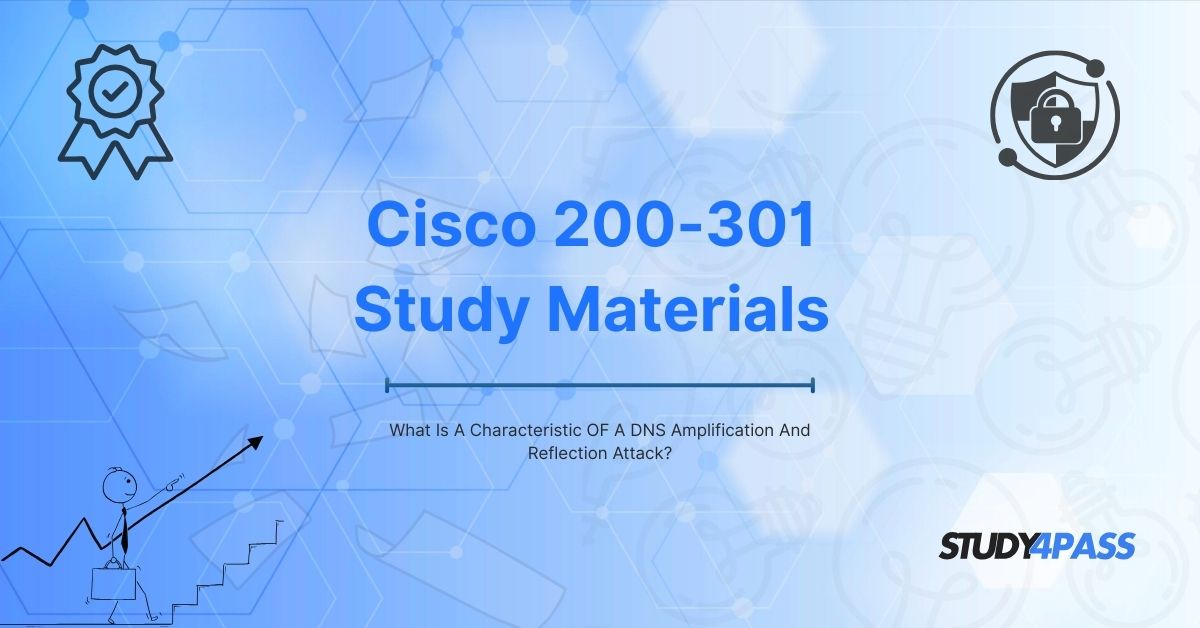Introduction CyberOps Associate (Version 1.0)
In the realm of cybersecurity, Distributed Denial-of-Service (DDoS) attacks remain one of the most prevalent threats to network infrastructure. Among the various DDoS attack techniques, DNS amplification and reflection attacks are particularly dangerous due to their ability to generate massive traffic volumes with minimal effort from the attacker.
This article explores the characteristics of DNS amplification and reflection attacks, their mechanisms, impacts, and mitigation strategies. Additionally, we will discuss how Study4Pass serves as an invaluable resource for students and professionals preparing for certifications like Cisco CyberOps Associate (200-201 CBROPS) and CCNA (200-301), providing structured learning materials to understand and combat such threats.
What is a DNS Amplification and Reflection Attack?
A DNS amplification and reflection attack is a type of DDoS attack where an attacker exploits the Domain Name System (DNS) to overwhelm a target with a flood of traffic. The attack involves:
- Reflection: The attacker sends DNS queries with a spoofed source IP address (the victim’s IP) to open DNS resolvers.
- Amplification: The DNS responses are much larger than the queries, creating a traffic multiplier effect.
This combination allows attackers to generate high-volume traffic with minimal resources, crippling the victim’s network.
Key Characteristics of DNS Amplification and Reflection Attacks
Exploiting DNS Protocol Design
- DNS operates over UDP (User Datagram Protocol), which is connectionless and does not validate source IPs, making it easy to spoof requests.
- DNS responses can be significantly larger than queries (amplification factor of 10x to 100x).
Use of Open DNS Resolvers
- Attackers target open (publicly accessible) DNS resolvers that respond to queries from any source.
- Misconfigured DNS servers amplify attack traffic by responding to spoofed requests.
Large Amplification Factor
- A small query (e.g., 60 bytes) can trigger a large response (e.g., 4000 bytes), multiplying attack traffic.
- Attackers leverage DNS record types like ANY, TXT, or DNSSEC-signed records to maximize response size.
Spoofed Source IP Addresses
- Attackers forge the source IP in DNS queries, redirecting responses to the victim.
- This makes it difficult for victims to block malicious traffic at the source.
High Bandwidth Consumption
- The attack floods the victim’s network with massive DNS responses, consuming bandwidth and causing service outages.
Difficulty in Traceability
- Since the attack uses legitimate DNS servers, tracing the original attacker is challenging.
- The distributed nature of the attack makes mitigation complex.
How DNS Amplification and Reflection Attacks Work?
Step-by-Step Attack Process
- Attacker Identifies Open DNS Resolvers – Scans for misconfigured DNS servers.
- Crafts Spoofed DNS Queries – Sends small DNS requests with the victim’s IP as the source.
- DNS Resolvers Respond to Victim – Each query triggers a large response sent to the victim.
- Traffic Overwhelms Victim’s Network – The flood of DNS responses causes a denial of service.
Real-World Examples
- 2016 Dyn Attack: One of the largest DDoS attacks, disrupting major websites like Twitter, Netflix, and Reddit.
- 2013 Spamhaus Attack: Peaked at 300 Gbps, leveraging DNS amplification techniques.
Impact of DNS Amplification Attacks
Network Disruption
- Overwhelms servers, routers, and firewalls, causing downtime.
Financial Losses
- Businesses lose revenue due to service unavailability.
Reputation Damage
- Prolonged outages erode customer trust.
Mitigation and Prevention Strategies
Rate Limiting and Filtering
- Restrict DNS query responses per IP to limit amplification.
Disabling Recursive Queries on Open Resolvers
- Configure DNS servers to only respond to authorized clients.
Implementing BCP38 (Network Ingress Filtering)
- Prevents IP spoofing at the ISP level.
Using Anycast DNS
- Distributes DNS traffic across multiple servers to absorb attacks.
Deploying DNSSEC
- Adds authentication to DNS responses, reducing spoofing risks.
Role of Study4Pass in Cybersecurity Education
For aspiring cybersecurity professionals preparing for Cisco CyberOps Associate (200-201 CBROPS) and CCNA (200-301), Study4Pass offers:
Comprehensive Study Materials
- Detailed guides on DDoS attacks, DNS security, and mitigation techniques.
Hands-On Labs and Simulations
- Practical exercises to understand attack vectors and defenses.
Exam Preparation and Certification Guidance
- Practice tests and expert tips to pass Cisco certifications.
Conclusion
DNS amplification and reflection attacks are a severe threat due to their high amplification potential and difficulty in mitigation. Understanding their characteristics helps network defenders implement effective countermeasures. Platforms like Study4Pass play a crucial role in educating cybersecurity professionals, providing the knowledge needed to combat such attacks.
Frequently Asked Questions (FAQs)
Q1: Why is UDP used in DNS amplification attacks?
A1: UDP is connectionless and does not validate source IPs, making spoofing easier.
Q2: How can organizations prevent DNS amplification attacks?
A2: By disabling open resolvers, implementing rate limiting, and deploying BCP38.
Q3: How does Study4Pass help in learning about DNS security?
A3: Study4Pass provides structured courses, labs, and exam prep materials for Cisco certifications, covering DNS attack mitigation.
Special Discount: Offer Valid For Limited Time “Cisco 200-301 Study Materials”
Sample Questions for Cisco 200-301 Prep
Actual exam question from Cisco's 200-301 Exam Guide.
1. What is the primary goal of a DNS amplification attack?
a) To steal sensitive DNS records
b) To overwhelm a target with a large volume of traffic
c) To modify DNS server configurations
d) To spread malware through DNS queries
2. How does a DNS reflection attack work?
a) By altering DNS query responses to redirect users
b) By spoofing the victim’s IP address to receive amplified responses
c) By infecting DNS servers with ransomware
d) By encrypting DNS traffic to prevent monitoring
3. Which protocol is commonly exploited in DNS amplification attacks?
a) HTTP
b) UDP
c) TCP
d) ICMP
4. Why are DNS amplification attacks considered dangerous?
a) They corrupt DNS cache permanently
b) They allow attackers to bypass firewalls easily
c) They generate high traffic volumes with minimal attacker effort
d) They expose user browsing history
5. What type of DNS query is often abused in amplification attacks?
a) AAAA (IPv6) records
b) MX (Mail Exchange) records
c) ANY (all records)
d) CNAME (Canonical Name) records


